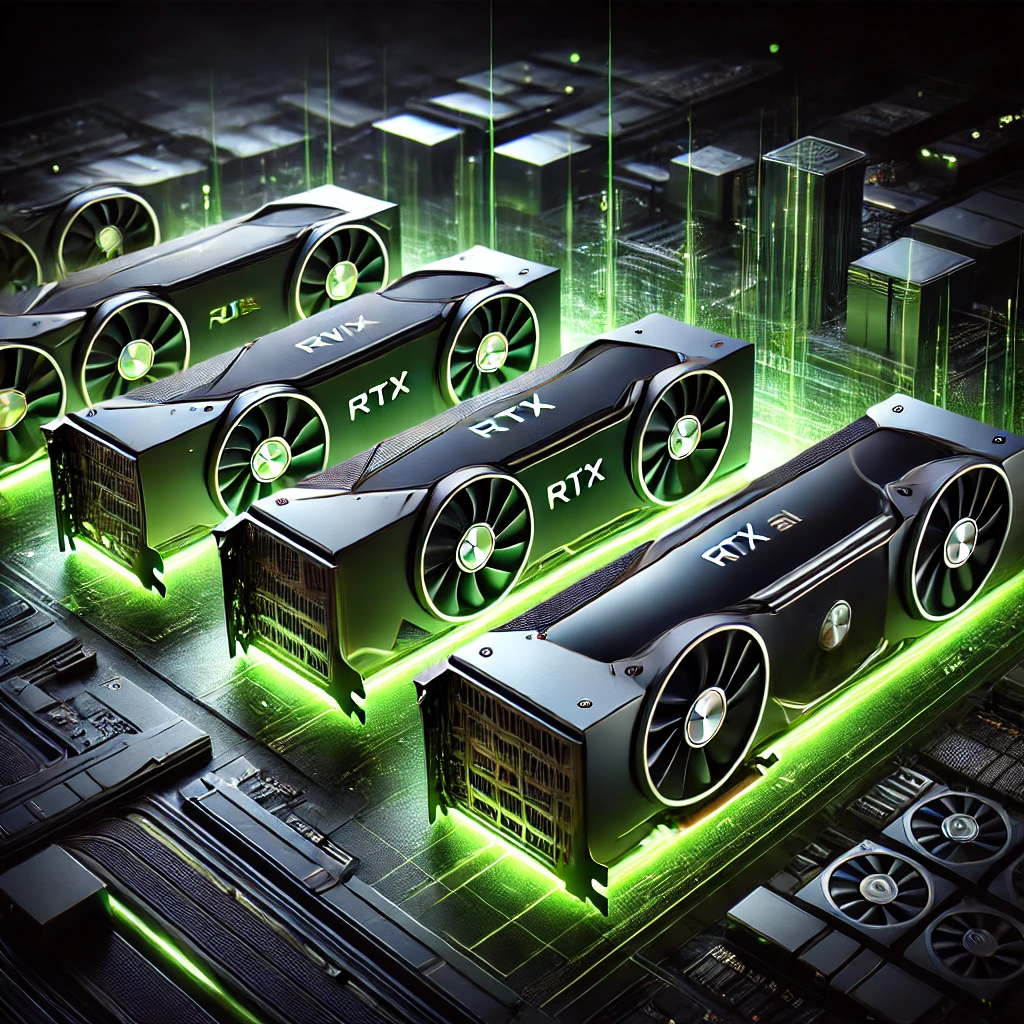Nvidia Unveils RTX 50-Series GPUs with DLSS 4 and Next-Gen Performance: RTX 5090, 5080, 5070 Ti, 5070 Specs and Pricing.
During its CES 2025 keynote, Nvidia announced its new RTX 50 series desktop graphics cards, as expected. The launch includes four GPUs: The four new RTX 5090, RTX 5080, RTX 5070 Ti, and RTX 5070. While bearing the “Blackwell” moniker, these architecture cards feature cutting-edge GDDR7 memory, advanced DLSS 4 multi-frame generation technology, and impressive performance claims that make them attractive to gamers and professionals. They plan to release the two flagship models on January 30, 2025, with the cheaper options released in February.
Here is a closer look at the new lineup, the technological advancements it brings, and what it means for the gaming and creative industries.
RTX 5090: The Best GPU Performance
The crown jewel is Nvidia’s RTX 5090, priced at $1999/£1939. For prosumers, it comes with 32GB of GDDR7 memory and a powerhouse GB202 GPU with 92 billion transistors, compared to the 4090’s 76 billion. While not a complete beast, this one has 21,760 CUDA cores with the promise of up to twice the frame rates of its predecessor. The card delivers a 4K, 240Hz experience with complete ray tracing and maxed-out game settings optimized for the new DLSS 4 multi-frame generation (MFG), Nvidia claims.
What is DLSS 4’s Multi Frame Generation?
With up to three synthetic frames generated for every traditionally rendered frame, frame rates are increased. This creates smoother visuals and a perceived fluidity. Sadly, it doesn’t boost the base performance and will struggle to stick to a 60 FPS frame rate, as the latter is still locked to your real frame rate. We must rely heavily on developer integration and Nvidia’s Reflex 2 system to mitigate latency.
However, the RTX 5090’s design is slim, surprisingly. Unlike the bulky quad-slot prototypes we were shown when the card was being developed, the Founders Edition is a two-slot card. It has a rated total graphics power (TGP) of 575W, which hangs just shy of the PCIe 5.0 600W limit and thus requires a 1000W PSU. It is feasible even in small form factor (SFF) PCs with a dual flow-through fan design and centrally placed PCB.
RTX 5080: $999 is our performance redefined.
For $999/£979, the RTX 5080 brings flagship performance at a relatively palatable price. Equipped with 16GB of GDDR7 memory, a GB203 GPU, and 10,752 CUDA cores, this card promises double the frame rates of the RTX 4080 in demanding titles such as Cyberpunk 2077, Alan Wake 2, and Black Myth: Wukong. Positioning it as an enthusiast-grade option, the 360W TGP and 850W PSU requirements put it in the same place.
Interestingly, Nvidia has priced the RTX 5080 on par with the RTX 4080 Super, and on paper, at least those hoping for comparative performance will do so in places where DLSS 4 isn’t being used.
RTX 5070 Ti and RTX 5070: Mid-Range Champions
The menu of RTX 5000 features also includes the midrange RTX 5070 Ti (£729 / $749) and RTX 5070 (£539 / $549), scheduled to arrive in February 2025. The RTX 5070 Ti comes with a pared-down GB203 GPU and 8,960 CUDA cores, whereas the RTX 5070 gets a much more powerful GB205 GPU packing 6,144 CUDA cores. The cards come in both 16GB and 12GB of GDDR7 memory.
Nvidia has claimed the RTX 5070 will deliver frame rates on par with the RTX 4090, while the RTX 5070 Ti seeks to double the performance of the RTX 4070 T. These comparisons are, however, heavily reliant on DLSS 4 MFG and may not translate to titles that are not optimized for DLSS or do not include ray tracing or DLSS support.
With a relatively meagre 12GB VRAM to its credit, the RTX 5070 could be a bottleneck in future AAA titles down the line; this is probably Nvidia’s realization of the inherent gamble it had to make with the RTX 5070 and perhaps a way to cut costs due to limited bandwidth on its 192-bit memory bus.
Architectural Innovations of the Blackwell Series
Powering the RTX 50-series is Nvidia’s Blackwell architecture, which means it’s packing substantial performance and efficiency improvements. Key innovations include:
- Enhanced Streaming Multiprocessors (SMs): Gaming and AI workloads benefit from greater throughput and tightly integrated Tensor cores.
- Improved Shader Execution Reordering: Renders more efficiently, wasting fewer processing cycles.
- Advanced Ray Tracing (RT) Cores: One of its latest features, it’s double the ray triangle intersection rates of previous generations.
- FP4 Compute Acceleration: It’s a performance boost for AI and machine learning applications.
- Multi-Frame Generation Hardware: The are specifically designed to take full advantage of the advancements in DLSS 4.
- PCIe 5.0 Support and DisplayPort 2.1b UHBR20 Ports: These ports guard against incompatibility with next-generation systems and high-resolution displays.
First, RTX 50–Series laptop GPUs will be arriving in March and promise great performance, up to three times more power efficiency, and 25 percent shorter charging times compared to previous generations.
Nvidia also revealed the RTX 50 series laptop GPUs, debuting in March 2025. This lineup is included in the mobile versions of the RTX 5090 (with 24GB), RTX 5080 (16GB), RTX 5070 Ti (12GB), and RTX 5070 (8GB). These GPUs attempt to bring desktop-level performance to portable devices at the cost of lower memory allocations.

What’s Next?
The RTX 50 series is a huge step forward in GPU technology and looks set to be spectacular, if not untethered, capable of gaming and content creation. Nvidia’s claims—especially regarding DLSS 4’s multi-frame generation—are impressive, but real-world testing will be critical to validate these gains. Comparisons with AMD’s and Intel’s products will be crucial in judging their worth when these GPUs arrive.
Keep an eye out for in-depth reviews, benchmarks, and further details on Nvidia’s groundbreaking Blackwell architecture. If you’re a professional gamer, content creator or anyone who is into AI, the RTX 50 series is promising to take you to places, something you’ve never experienced before in 2025.






